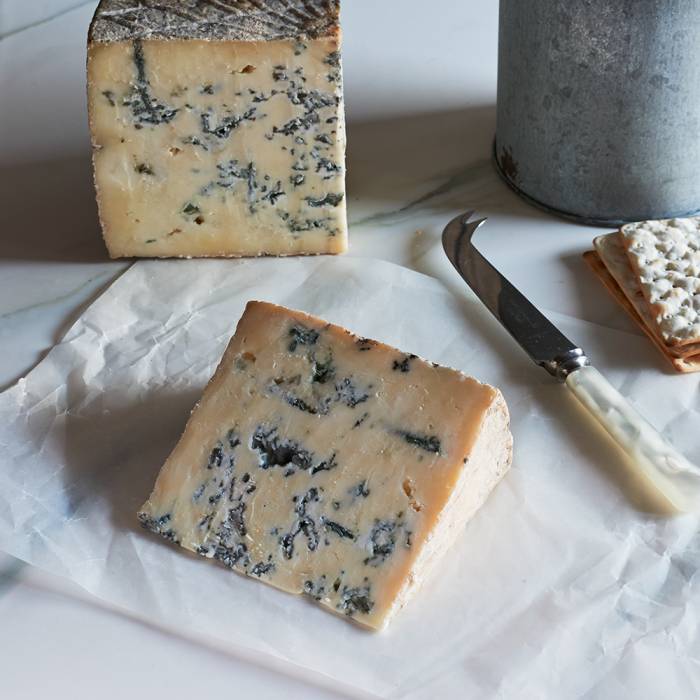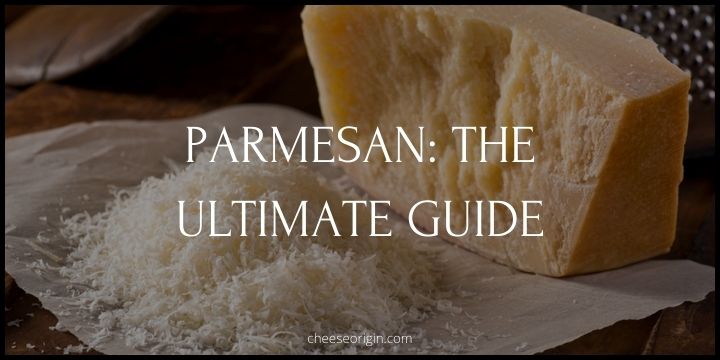What is Devon Blue? The Blue Jewel of Britain

Devon Blue, often referred to as the ‘Blue Jewel of Britain,’ is a distinguished and exquisite cheese hailing from the rolling hills and lush pastures of Devonshire, England. Infused with a robust yet creamy flavor profile, this cheese is a testament to the region’s rich dairy heritage. Made using vegetarian rennet, and available in both pasteurized and unpasteurized versions, Devon Blue offers a unique sensory journey.
Quick Facts About Devon Blue
| Quick Facts | Details |
|---|---|
| Origin | Devon, England |
| Producer | Ticklemore Cheese Company |
| Cheese Type | Blue cheese |
| Milk Source | Cow’s milk |
| Texture | Firm and crumbly |
| Flavor Profile | Rich, buttery, slightly sweet with a sharp finish |
| Aging Time | Minimum of 3 months |
| Appearance | Ivory-colored paste with blue-green veining |
| Pairings | Port, Riesling, full-bodied red wines, figs, pears, honey |
| Best Used In | Cheese platters, salads, melted-on steaks |
| Production Method | Handmade |
| Vegetarian? | Yes, made with vegetarian rennet |
| Protected Designation | Not protected by PDO or PGI |
| Shelf Life | Approximately 2-3 weeks once cut |
What is Devon Blue?

Devon Blue, a creamy, crumbly wonder from the heart of Britain, is an artisanal blue cheese that stands as a testament to traditional cheesemaking. Produced by the renowned Ticklemore Cheese Company in Devon, England, this cheese is a celebration of local flavors and techniques handed down through generations.
Crafted from the milk of cows grazing on the lush, green pastures of Devon, this blue cheese boasts a unique flavor profile. Its firm and crumbly texture gives way to a rich, buttery taste that is slightly sweet yet ends with a sharp finish. The ivory-colored paste is beautifully marred by blue-green veins, a result of the aging process that takes a minimum of three months.
But Devon Blue isn’t just about taste and appearance. It’s about an experience. When paired with Port, Riesling, or a full-bodied red wine, its flavors truly come alive. Add it to a cheese platter, toss it in a salad, or melt it over a steak and you’ll understand why this cheese has won the hearts of gourmands worldwide.
Handmade and vegetarian-friendly, Devon Blue showcases the passion and dedication of its makers. It may not have a Protected Designation of Origin (PDO) or a Protected Geographical Indication (PGI), but its quality and flavor are undeniable. Just remember, once cut, its shelf life is approximately 2-3 weeks, so savor every bite of this British blue cheese wonder.
What Does Devon Blue Taste Like?
Devon Blue cheese is a sensory delight with a complex flavor profile. It is characterized by a rich, buttery taste that is somewhat different from other blue cheeses. Its initial flavor is mellow and slightly sweet, which gradually gives way to a sharper, more pronounced tang, typical of blue cheeses.
The cheese also has an earthy undertone, thanks to the natural flora of Devon where the milk-producing cows graze. The blue-green veins running through the cheese add a hint of spiciness and a slight mineral note, enhancing the overall complexity of its flavor.
The texture of Devon Blue also plays a part in its taste experience. Its firm and crumbly body allows for a slow release of flavors, making each bite a journey from sweet to savory to sharp. Despite its robust flavor, Devon Blue finishes smoothly, leaving a lingering creaminess on the palate.
Devon Blue Tasting Notes
- Origin: Devon, England, made by the Ticklemore Cheese Company
- Type: Blue cheese made from cow’s milk
- Texture: Firm and crumbly
- Color: Ivory with blue-green veining
- Taste: Starts off rich and buttery, slightly sweet
- Flavor Development: Gradually evolves into a sharper, more pronounced tang
- Additional Notes: Earthy undertones with a hint of spiciness from the blue veins
- Finish: Smooth and creamy, leaving a lingering taste on the palate
How to Eat Devon Blue?
- Cheese Board: Due to its unique flavor profile, Devon Blue can be the star of your cheese board. Pair it with a variety of crackers, fresh fruits like grapes and figs, and a dollop of sweet honey for a perfect balance.
- Perfect Pairing: Try pairing Devon Blue with wines that can complement its rich, tangy flavor. Port, Riesling, or a full-bodied red wine are excellent choices.
- Culinary Delight: Melt Devon Blue over a juicy steak or a gourmet burger for an elevated dining experience. The cheese’s creamy texture and sharp flavor adds a luxurious touch.
- Salad Booster: Crumble Devon Blue into your salads. It pairs well with fresh greens, walnuts, and a sweet balsamic reduction.
- Bake It: Incorporate Devon Blue into your baking. It’s delicious in a savory tart or quiche, adding depth and a creamy, tangy note.
- Pasta Upgrade: Stir chunks of Devon Blue into warm pasta. Its richness enhances the dish, especially when paired with earthy ingredients like mushrooms.
- Breakfast Champion: Spread it on a warm piece of toast or bagel for a hearty breakfast. It’s a great way to start the day with a punch of flavor.
- Sweet Pairing: For a dessert option, pair Devon Blue with sweet pears or apples. The contrast between the tangy cheese and sweet fruit is a delightful palate-pleaser.
10 Best Devon Blue Substitutes
| Substitute | Origin | Short Description |
|---|---|---|
| Stilton | England | Known as “The King of Cheeses”, Stilton is crumbly, rich, and has a strong, tangy flavor. It’s a good alternative for Devon Blue. |
| Bath Blue | England | An organic, creamy blue cheese with a mild flavor and moist texture. It’s similar to Devon Blue but less spicy. |
| Rebel Nun | England | A semi-soft cheese with a unique, tangy flavor and a hint of citrus. It’s an interesting substitute to the traditional Devon Blue. |
| Beenleigh Blue | England | A sheep’s milk blue cheese, it has a crumbly texture and sweet, nutty flavor. The taste is milder than Devon Blue. |
| Cornish Blue | England | Unlike most blue cheeses, Cornish Blue is designed to be enjoyed as a young cheese. It has a mild, gentle flavor with a creamy texture. |
| Roquefort | France | Known for its tangy, salty flavors with a hint of sweetness. This sheep milk cheese could work as a substitute for Devon Blue. |
| Gorgonzola | Italy | Creamy with a distinct, sharp flavor. Gorgonzola can serve as a stronger, more pungent alternative to Devon Blue. |
| Cambozola | Germany | A hybrid of French soft-ripened triple cream cheese and Italian Gorgonzola. It’s milder and creamier than Devon Blue. |
| Danish Blue | Denmark | Known for its sharp, salty flavor and creamy texture. It’s a good alternative if you prefer a less intense blue cheese. |
| Bleu d’Auvergne | France | With a strong, pungent flavor and moist, creamy texture, it can be a good substitute for Devon Blue. |
What Pairs Well With Devon Blue?

Food that goes well with Devon Blue:
| Category | Food Pairing |
|---|---|
| Cheese | Smokey Blue from Rogue Creamery, Ticklemore Goat from Sharpham Cheese |
| Meat | Bacon (pairs well with smokey blue cheeses) |
| Fish | Blue cheese often pairs well with oily fish like salmon or mackerel |
| Fruit | Apples, grapes, pears |
| Nuts | Walnuts |
| Sweet Spreads | Honey, fruit compotes, chutneys |
| Savory Dishes | Salads, sandwiches, burgers, pizzas |
| Other Cheeses | Beenleigh Blue, Cornish Blue, Bath Blue |
Also read: 11 Best Crackers that Pair Well with Cheese
Beverage that goes well with Devon Blue:
| Category | Beverage Pairing |
|---|---|
| Wine | Port, Riesling, full-bodied Red Wine |
| Beer | Stout, Belgian-style Ales, IPA |
| Whiskey | Bourbon, Single Malt Scotch |
| Non-Alcoholic | Sparkling Water, Apple Cider |
| Tea | Earl Grey, Darjeeling |
| Coffee | Espresso, French Press |
Also read: Best Wine and Cheese Pairings: The Ultimate Guide
Frequently Asked Questions
1. Is Devon blue cheese vegetarian?
Yes, Devon Blue cheese is vegetarian. It is made using vegetarian rennet.
2. How to store Devon blue cheese?
Storing Devon Blue cheese correctly is important to maintain its quality and flavor. Here are 5 steps on how to store it:
- Wrap It Properly: Use cheese paper, parchment paper, or wax paper to wrap the cheese. Avoid using plastic wrap as it can suffocate the cheese and promote bacterial growth.
- Refrigerate: Store your wrapped cheese in the vegetable crisper of your refrigerator, which tends to maintain a consistent temperature while providing some humidity.
- Avoid Cross-Contamination: Store your cheese separately from other strong-smelling foods. The cheese can absorb the flavors of these foods, altering its taste.
- Check Regularly: Check your cheese regularly to make sure it’s not drying out or developing mold. If it is, trim off the moldy part and rewrap the cheese in fresh paper.
- Bring to Room Temperature Before Serving: For the best flavor, take the cheese out of the fridge an hour before you plan to eat it.
Remember, cheese is a living product and continues to mature. Proper storage helps control the maturing process.
Also read:
- What is Cabrales? Spain’s Artisan Blue Cheese Delight
- What is Picos de Europa? Spain’s Blue Cheese Gem
- What is Monte Enebro? The Tangy Temptation
- What is Stichelton? The True Stilton’s Alternative
- What is Dubliner Cheese? From Irish Pastures to Global Tables
- What is Labneh Cheese? A Middle Eastern Culinary Secret
- What is Roncal? A Taste of Spanish Heritage





